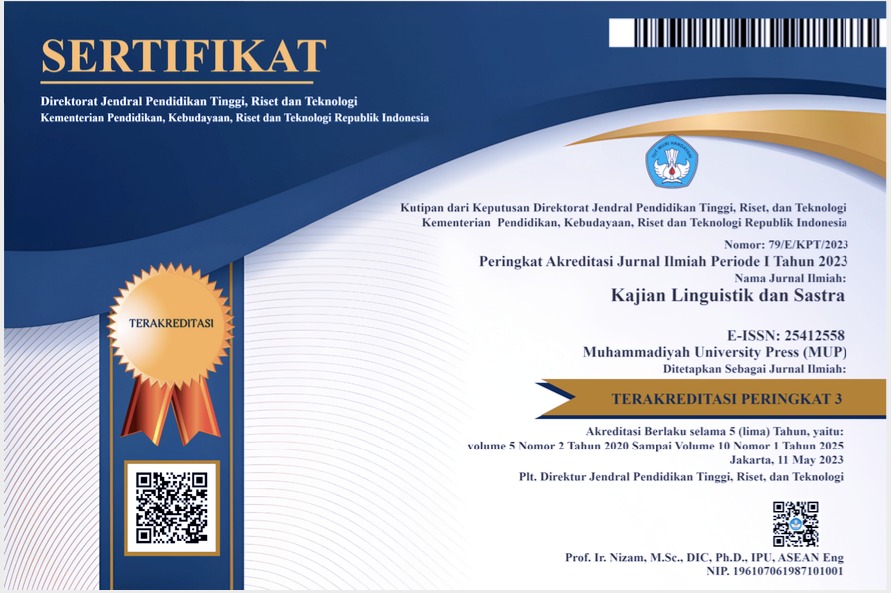Transformasi Ruang Publik Digital: Studi Kasus Komentar Netizen dalam Akun Curhat
Abstract
In the current era of digital technology, the various digital platforms available in the form of social media mean that anyone can express as many things as they wish. Social media seems to be a personal "journal" but can be connected to the virtual world community or netizens so that netizens can also monitor the social media activities of each individual. One of the uses of social media by netizens is as a place to "talk" and respond to each other. These netizens do not know each other personally in the digital space. Uniquely, they do not hesitate to express personal experiences, then netizens respond ideally when the speaker and the interlocutor communicate directly. Cermin Lelaki's Instagram account presents a social media concept that is used as a forum for receiving men's conversations with various life problems. The story was then shared with the public and received many comments from netizens. Using the method of observing the language interactions of netizen comments on the Cermin Lelaki account, this research aims to explore netizen comments in response to venting and explore the extent to which the existence of digital public space can shape configurations or patterns of language activity from netizen comments. Language activities in netizen interactions are influenced by many underlying factors.
References
M. and W. H. D. Graham, Society and the Internet: How Networks of Information and Communication are Changing Our Lives. Oxford: University Press Scholarship Online, 2014.
A. S. P. Langi, M. Natsir, and S. Anam, “Analisis Pemanfaatan Platform Media Sosial dalam Perdagangan Pakaian Jadi di Pertigaan Kampus Universitas,” Value Added Maj. Ekon. dan Bisnis, vol. 18, no. 1, p. 22, 2022, doi: 10.26714/vameb.v18i1.9629.
R. Kertamukti et al., “Kontruksi ldentitas melalui Stories Highlight Instagram Kalangan Kelas Menengah,” pp. 26–44.
B. Thiodanu and W. P. Sari, “Fenomena Curhat Online pada @Cerminlelaki di Instagram,” Koneksi, vol. 3, no. 2, p. 435, 2020, doi: 10.24912/kn.v3i2.6445.
N. Irsyad, L. Nuryasin, and S. Setyawan, “Pemanfaatan Instagram sebagai Media Komunikasi Pemasaran (Studi Kasus pada Akun Instagram @Limeliterentalkamera &@Sololensa),” J. Ilmu Komun. UHO J. Penelit. Kaji. Ilmu Sos. dan Inf., vol. 8, no. 4, pp. 816–831, 2023, [Online]. Available: http://jurnalilmukomunikasi.uho.ac.id/index.php/journal/indexDOI:http://dx.doi.org/10.52423/jikuho.v8i4.118.
F. Moekahar and A. Amalia, “The Identity Construction of Young Gay on Instagram,” vol. 13, no. 2, pp. 133–146, 2021, doi: 10.26623/themessenger.v13i2.1003.
C. Purwanti, “Eksistensi Bahasa dalam Komunikasi Interpersonal : Sebuah Pendekatan Interdisipliner [Language Existence In Interpersonal Communication: an Interdiciplinary Approach ],” vol. 16, no. 2, pp. 266–281, 2020.
Arianto, “‘Menuju Persahabatan’ Melalui Komunikasi Antarpribadi Mahasiswa Beda Etnis,” Krit. J. Sos. Ilmu Polit. Univ. Hasanuddin, vol. 1, no. 2, pp. 219–229, 2015.
J. T. Atmodjo, “Media Massa dan Ruang Publik,” J. Visi Komun., vol. 14, 2015.
J. Van Dijck and T. Poell, “Social Media and the Transformation of Public Space,” 2015, doi: 10.1177/2056305115622482.
H. Fernando, Y. G. Larasati, and S. Z. Qudsy, “The Viral of Hadist: Dimensi dan Makna Meme #Hadis dalam Media Sosial Instagram,” Satya Widya J. Stud. Agama, vol. 6, no. 1, pp. 74–90, 2023, doi: 10.33363/swjsa.v6i1.961.
S. Suh, Non ‑ Boundaries of Style Represented in Fashion Instagram: a Social Media Platform As A Digital Space– Time. Springer Singapore, 2020.
R. Wijayava and S. Arumi, “English Blends Found in Social Media,” vol. 2, 2017.
I. R. Putri and E. Pratiwi, “Aktivisme Digital dan Pemanfaatan Media Baru sebagai Pendekatan Pemberdayaan Masyarakat Atas Isu Lingkungan,” Bricol. J. Magister Ilmu Komun., vol. 8, no. 2, p. 231, 2022, doi: 10.30813/bricolage.v8i2.3303.
R. S. Qamaria, F. Zahro, U. Na, I. N. Agnia, and A. Ashlihi, “Edukasi Stop KDRT melalui Pemanfaatan Media Sosial Instagram,” vol. 1, no. 2, pp. 113–121, 2022.
Sakinah, “Selebgram: Meraih Popularitas di Dunia Maya,” Etnosia J. Etnogr. Indones., vol. 3, pp. 48–71, 2018.
P. R. R. Martin, J.R.& White, The Language of Evaluation: Appraisal in English. London: Palgrave, 2005.
Hestiyana, “Ujaran Kebencian terhadap Presiden Jokowi sebagai Capres Petahana di Media Sosial: Kajian Linguistik Forensik,” Balai Bhs. Kalimantan Selatan, pp. 696–707, 2019.
R. Tiani, J. S. Sistem, and M. Cetak, “Nusa, Vol. 12. No. 4 November 2017 Riris Tiani, Judgement sebagai Sistem Appraisal dalam Iklan Kecantikan Visual Media Cetak,” vol. 12, no. 4, pp. 256–264, 2017.
R. D. Safitri, M. Mulyani, and Farikah, “Teori Tindak Tutur dalam Studi Pragmatik,” KABASTRA Kaji. Bhs. dan Sastra, vol. 1, no. 1, pp. 59–67, 2021, doi: 10.31002/kabastra.v1i1.7.
T. Fitriyah, A. K. Nashoih, Q. Fajar, and S. M. Husain, “Expressive Speech Act in Comments on Instagram BBC Arabic,” vol. 14, no. 2, pp. 324–344, 2022, doi: 10.24042/albayan.v14i2.12127.
J. L. Austin, How to Do Things with Words. London: Clarendon Press, 1962.
Y. dkk. Mubarok, “Hate Speech in The Comments’ Column: a Discourse Analysis,” vol. 12, no. 1, pp. 439–450, 2024.
J. R. Searle, Expression and Meaning. Cambridge University Press, 1979.
M. Gervasio and M. Karuri, “Marking Identity through Language in Social Media Discourse by Chuka University Students,” vol. 7, no. 8, pp. 43–52, 2019.










